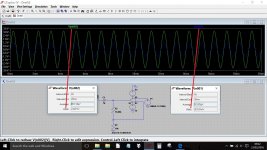The caps are needed because all the opamp pins (input and output) are biased to half supply. So you need to ensure that whatever you connect to the input doesn't change that DC value... hence the cap. The output is AC coupled to 'remove' the 7.5 volts and just allow the AC signal through.
I can't think of any one specific document that explains that, its just general circuit theory and practice.
I can't think of any one specific document that explains that, its just general circuit theory and practice.
How you decide the values of capacitors???
How you told me that, by changing R6 you will get correct output?
How you told me that, by changing R6 you will get correct output?
You need to take into account the frequencies the circuit will work with in order to calculate the cap values. Again, this is basic theory you need to read and understand.
These are called 'first order' filters and in your circuit they are 'high pass' types.
RC filters, integrators and differentiators
These are called 'first order' filters and in your circuit they are 'high pass' types.
RC filters, integrators and differentiators
Is it possible to design instrumentation amplifier with only one input signal and making other signal as ground? Adding phase reversal circuitary will add more cost and complications to the design?
Last edited:
What are you trying to do or make ? An amplifier with only one input isn't an instrumentation amp.
I need to design a voltage amplifier which can amplify signal of mv to +5V, with high accuracy, stability and sensitivity.
So is this some school/college project... just so we know 🙂
That bit doesn't make sense. To take a varying input signal and process it to always get +5v output needs something different to a linear amplifier.
amplify signal of mv to +5V, with high accuracy, stability and sensitivity
That bit doesn't make sense. To take a varying input signal and process it to always get +5v output needs something different to a linear amplifier.
You've written 2.666 which is a low gain.
You also need to define what the expected type of input signal is. Is it AC, DC or both. Maximum and minimum frequencies it is expected to handle. Input impedance.
You also need to define what the expected type of input signal is. Is it AC, DC or both. Maximum and minimum frequencies it is expected to handle. Input impedance.
But, circuit should not have dual power supply (neither AC nor DC). I am provided only with positive supply source, even I cant reverse the polarity and use it
Well that's a really low gain which means any common opamp will work.
Next you have to decide whether the amp it to be inverting of overall phase or not, and then based on that calculate the basic value of the gain setting resistors.
Now you've shown that you can use LTspice so I'm not going to do all the hard work for you 😉 (and you won't learn anything)
Fig #1 in this document shows non inverting and figure #2 shows inverting. Calculate the resistor values you need and put them into a real (well a simulated) circuit and prove you have them correct.
http://www.ti.com/lit/an/slaa068a/slaa068a.pdf
If you get that far then we can look at refining it a bit further.
Next you have to decide whether the amp it to be inverting of overall phase or not, and then based on that calculate the basic value of the gain setting resistors.
Now you've shown that you can use LTspice so I'm not going to do all the hard work for you 😉 (and you won't learn anything)
Fig #1 in this document shows non inverting and figure #2 shows inverting. Calculate the resistor values you need and put them into a real (well a simulated) circuit and prove you have them correct.
http://www.ti.com/lit/an/slaa068a/slaa068a.pdf
If you get that far then we can look at refining it a bit further.
I tried this way also, but rather then becoming an amplifier it becomes voltage follower. I read some where with such low input voltage, op amps gives a max voltage of 3.5 and not more then that.
That circuit is OK but you don't at this stage need to add an offset to the input voltage. Your gain calculates out at exactly 2.666 and LT confirms that. If you divide the rms value of the output voltage by the input as shown by LT you get 2.66599
Opamps can give gains of many hundreds, many thousands even.
Do you want it to have an offset ?
If the amplifier is to amplify any offset present (because then the offset is a valid part of the signal) then it needs to be a DC coupled amp running on dual supplies.
If you want to ignore the offset then you need to AC couple the input (and then you can use the single supply).
If the amplifier is to amplify any offset present (because then the offset is a valid part of the signal) then it needs to be a DC coupled amp running on dual supplies.
If you want to ignore the offset then you need to AC couple the input (and then you can use the single supply).
- Status
- Not open for further replies.
- Home
- Source & Line
- Analog Line Level
- Instrumentation amplifier
